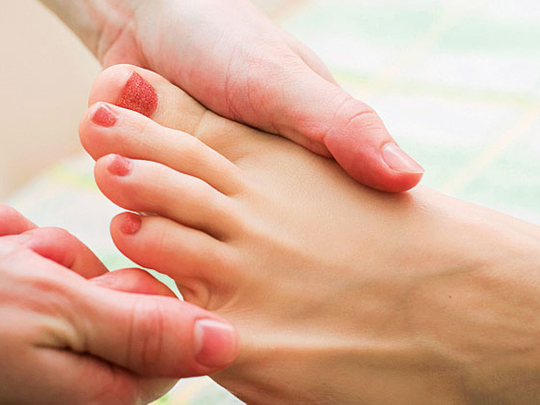
I occasionally experience numbness in my big toe which lasts around a week. I do not have diabetes and eat well and exercise regularly. I would also like to take thriphala* and wondered if you can get it in Australia.
Numbness of the toes generally is a result of conditions that affect the nerves and/or blood vessels that supply the foot. It is often associated with tingling, which is referred to as paresthesia of the toes. There are various causes. A tingling in the fingers or toes is a common symptom of anxiety. However, it can also be caused by a number of organic conditions such as diabetes, Tarsal tunnel syndrome, vascular disease and neurological disorders. As you are a non-diabetic, diabetic neuropathy is ruled out. Simple causes like sitting cross-legged for a long time as well as health concerns like sciatica, spondylolisthesis, injuries, demyelinating diseases, Raynaud's phenomenon (constriction and narrowing of the capillaries of the fingers and toes), can cause toes to become numb.
Meet an Ayurvedic doctor. Massaging the toes and legs with sesame oil, can help in the treatment of numbness. One must also increase the intake of vitamins and minerals through a balanced diet. Thriphala can be purchased in Australia or via online shopping.
My husband frequently complains of sharp head pains. He used to do a few yoga exercises relating to the head, but this led to neck pain so he stopped doing them. Please advise.
I have several queries in order to understand his condition:
- Where is the pain located? Is it a superficial scalp pain or a headache?
- Is the neck pain persistent?
- How is the onset - gradual or sudden?
- How long does the pain last?
- Is the pain recurrent? Is it daily? Does it happen at the same time every day?
- Do any activities worsen his pain, such as bending forward, eating, sleep patterns or stress?
- How does he get relief - through rest, simply lying down, or medication?
- Is his pain accompanied by any other symptoms, for example, a stuffy nose, vision problems, difficulty in speaking, nausea?
An average of nine in ten adults will experience a headache sometime in their life. Primary headaches (tension headaches, cluster headaches, and migraine) occur independently and are not caused by any medical condition.
They account for about 90 per cent of all headaches. Secondary headaches are associated with underlying conditions including fever, infection, high blood pressure, psychiatric disorders, head injury, stroke, tumours, and nerve disorders.
Head pain also can result from syndromes involving the eyes, ears, neck, teeth, or sinuses. In these cases, the underlying condition must be diagnosed and treated. Also, certain types of medication produce headaches as a side effect. A patient should seek medical attention if their headache is sudden or severe.
Consult a GP if the headache is accompanied by nausea or vomiting, a stiff neck, rash, confusion, seizures, double vision, numbness or difficulty in speaking.
Home tips for primary headaches:
- Drink warm milk at bedtime.
- Rub two to three drops of ghee on the crown (scalp.)
- Favour green gram, black gram and horse gram in your diet (if not suffering from acidity.)
- Apply Bala Thailam* on the scalp before a shower.
The certified ayurvedic consultant will answer health-related beauty queries exclusively for readers of Friday.
Contact:
Email friday@gulfnews.com
Fax 04 344 1627
Write to Well-being, Friday, PO Box 6519, Gulf News, Dubai, UAE











